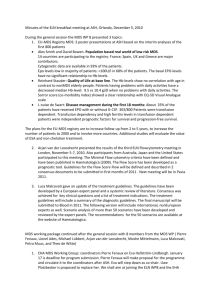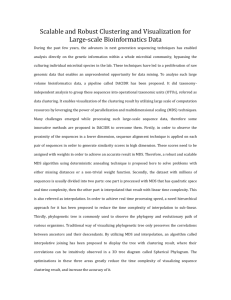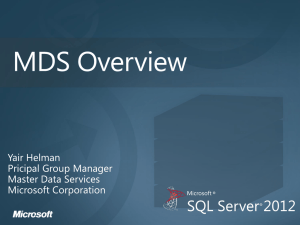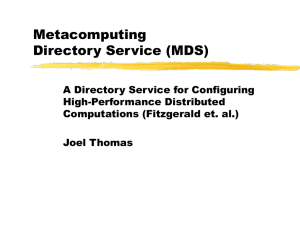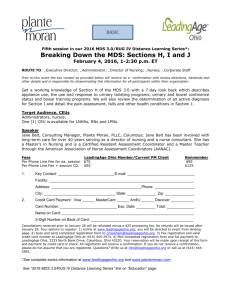Minutes MDS WP8 meeting
advertisement
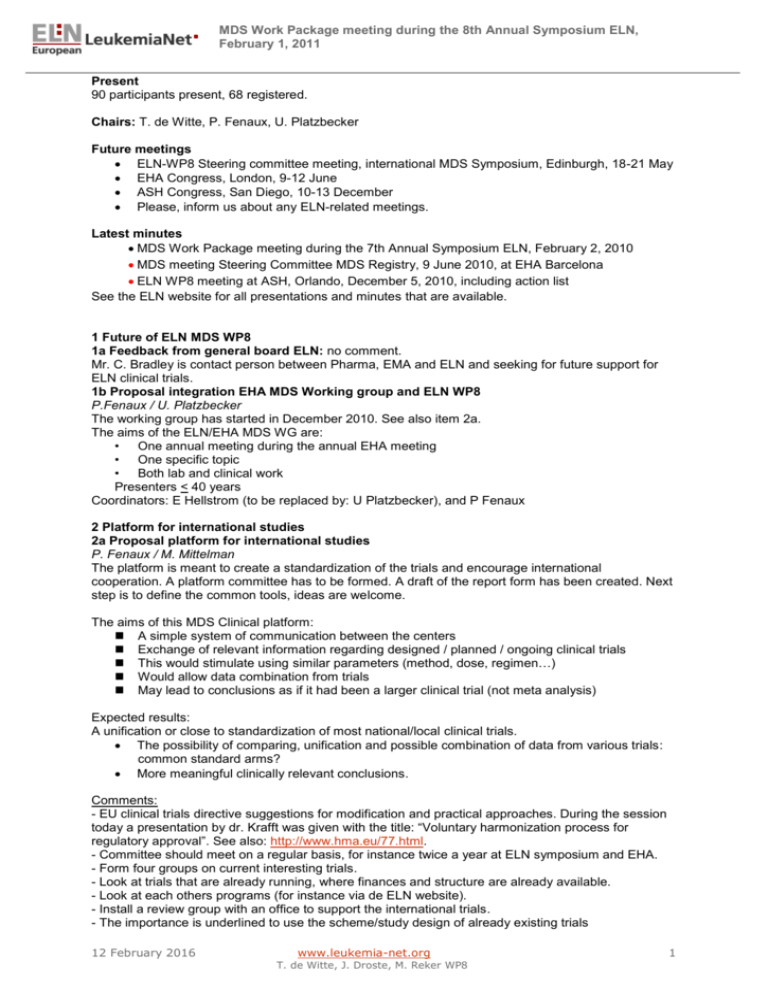
MDS Work Package meeting during the 8th Annual Symposium ELN, February 1, 2011 Present 90 participants present, 68 registered. Chairs: T. de Witte, P. Fenaux, U. Platzbecker Future meetings ELN-WP8 Steering committee meeting, international MDS Symposium, Edinburgh, 18-21 May EHA Congress, London, 9-12 June ASH Congress, San Diego, 10-13 December Please, inform us about any ELN-related meetings. Latest minutes MDS Work Package meeting during the 7th Annual Symposium ELN, February 2, 2010 MDS meeting Steering Committee MDS Registry, 9 June 2010, at EHA Barcelona ELN WP8 meeting at ASH, Orlando, December 5, 2010, including action list See the ELN website for all presentations and minutes that are available. 1 Future of ELN MDS WP8 1a Feedback from general board ELN: no comment. Mr. C. Bradley is contact person between Pharma, EMA and ELN and seeking for future support for ELN clinical trials. 1b Proposal integration EHA MDS Working group and ELN WP8 P.Fenaux / U. Platzbecker The working group has started in December 2010. See also item 2a. The aims of the ELN/EHA MDS WG are: • One annual meeting during the annual EHA meeting • One specific topic • Both lab and clinical work Presenters < 40 years Coordinators: E Hellstrom (to be replaced by: U Platzbecker), and P Fenaux 2 Platform for international studies 2a Proposal platform for international studies P. Fenaux / M. Mittelman The platform is meant to create a standardization of the trials and encourage international cooperation. A platform committee has to be formed. A draft of the report form has been created. Next step is to define the common tools, ideas are welcome. The aims of this MDS Clinical platform: A simple system of communication between the centers Exchange of relevant information regarding designed / planned / ongoing clinical trials This would stimulate using similar parameters (method, dose, regimen…) Would allow data combination from trials May lead to conclusions as if it had been a larger clinical trial (not meta analysis) Expected results: A unification or close to standardization of most national/local clinical trials. The possibility of comparing, unification and possible combination of data from various trials: common standard arms? More meaningful clinically relevant conclusions. Comments: - EU clinical trials directive suggestions for modification and practical approaches. During the session today a presentation by dr. Krafft was given with the title: “Voluntary harmonization process for regulatory approval”. See also: http://www.hma.eu/77.html. - Committee should meet on a regular basis, for instance twice a year at ELN symposium and EHA. - Form four groups on current interesting trials. - Look at trials that are already running, where finances and structure are already available. - Look at each others programs (for instance via de ELN website). - Install a review group with an office to support the international trials. - The importance is underlined to use the scheme/study design of already existing trials 12 February 2016 www.leukemia-net.org T. de Witte, J. Droste, M. Reker WP8 1 MDS Work Package meeting during the 8th Annual Symposium ELN, February 1, 2011 Action: P. Fenaux will make a proposal and will coordinate the group containing: P. Fenaux, M. Mittelman, U. Platzbecker, L. Ades, T. de Witte, A. van de Loosdrecht, A. Ganser, A. Giagounidis. 2b Vidaza, Lenalinomide in MDS U. Platzbecker / L. Ades Lenalidomide combined to Aza for high risk MDS with Del5q. This phase II study initially looked at the frequency of cytogenetic abnormalities in MDS and the survival of patients with Del5q. The outcome: o Thirteen of the 47 patients (27%) achieved response according to IWG 2006 criteria, including 7 (15%) CR, 2 marrow CR, and 4 erythroid hematologic improvement. o RBC transfusion independence was achieved in 12 patients (25%), including the 7 CR, one of the marrow CR, and the 4 HI-E. The next question was how to improve the outcome for instance with a high dose of chemotherapy or combination therapy. This Vidaza study is an ongoing trial with : o N=11 o All with complex caryotype o Elderly patients ( up to 86 years) o Treatment is as expected myelotoxic o but efficient (3 CR/11 pts after 2 cycles) The objective is to identify the combination of AZA and one of 3 proposed drugs (Valproic Acid, Lenalidomide, Idarubicine), those arms whose responses rates after 6 courses in adult high and int-2 MDS (IPSS) will be significantly higher than that of the control arm (Azacitidine alone). This can form the basis of a platform study with Vidaza in the control arm. Comments: - Idea to include in future trials patients who are lower-risk with IPSS, but high risk with WPSS. 3 Standardization of flow cytometry in MDS A. van de Loosdrecht Report from the third ELN workshop on FC in MDS, 4-6 Nov. 2010, London. Representatives from 12 countries, 28 participants, in- and outside Europe. In London recommendations are identified for the analysis of subsets in the BM. An ELN consensus document of MDS and FC has been created. Publications have reported on: analysis of a minimized multiparameter panel, analysis of myelomonopoiesis and FCSS related to transfusion-dependancy and progression to AML. FC has been recognized as an important tool in diagnostic and prognostic work-up of patients with cytopenia; the ELN consensus guideline is available and a rationale for clinical application has been defined. Perspectives for the future have been defined as well and more publications are planned in 2011. Comments: FC can also be used in other diseases with dysplasia There are clear abnormalities seen in MDs which are not assessed in patients with other diseases. There is no solution yet for ICUS patients. A FC pediatric study is planned in 2012. Both bone-marrow and blood can be used, but at the moment bone-marrow is preferred. 4 Therapeutic guidelines L. Malcovati / T. de Witte Due to absence of dr. Malcovati, T. de Witte presents slides with the methods and the web-based scenario analysis of treatment of MDS. There are 50 scenarios on the website, experts will analyze the input and give feedback on the therapeutic guidelines. Request for all: follow the web-based training program on: http://mds.haematologica.org/ 12 February 2016 www.leukemia-net.org T. de Witte, J. Droste, M. Reker WP8 2 MDS Work Package meeting during the 8th Annual Symposium ELN, February 1, 2011 5 Translational research J. Jansen J. Jansen proposes to evaluate the wishes and possibilities in the EUMDS registry. The aim is to enhance the value of the MDS Registry by matching biobanking. Cells: • Bone marrow mononuclear cells (DNA + RNA • Peripheral blood mononuclear cells/granulocytes (DNA + RNA) • Buccal swap or hair (DNA) • Serum • Viable cells (only in dedicated centers?) Method: • Isolation of mononuclear cells (Ficoll / red cell lysis) locally • Take up cells in DNA lysis buffer and RNAbee • Freeze sample • Send to central lab for processing Issues: • Ownership • Scientific board decides whether research questions fit the goals of the registry • Informed consent • ICT database coupled to registry • Financing Action: J. Jansen will send a questionnaire to participants of the Registry to evaluate possibilities and wishes. 6 MDS Registry 6a Progress of MDS Registry The milestone of 1000 inclusions has been reached. The follow-up period has been extended to 3 years, the 4th and 5th year is likely to be sponsored by Novartis as well. 6b Presentation of second interim analysis (first 800 patients) A. Smith / T. de Witte Objectives Primary - To describe the demographics and disease management of newly diagnosed patients with IPSS low and intermediate-1 MDS. Secondary - Investigating the association between: - Demographic and clinical characteristics at time of inclusion - Secondary iron overload due to transfusions - Treatment received With - Overall survival - Time to Leukaemia Progression (TLP) - Performance Status Recruitment & Visit Summary Statistics - N=800, diagnosed between Jan 2008 to July 2010 - Time between Date of Diagnosis to Inclusion o Median 42 days (range 0 to 98 ) - Mean number of visits per subject 2.3 (range 1 to 6) - Time between 1st Visit and 2nd Visit o Median 157 days (range 63 to 590) Conclusions • This registry records data from the ‘real world’ • The EUMDS registry demonstrates the importance of detailed disease-management in lowand intermediate-1 risk MDS patients See the ELN website for the complete analysis. 12 February 2016 www.leukemia-net.org T. de Witte, J. Droste, M. Reker WP8 3 MDS Work Package meeting during the 8th Annual Symposium ELN, February 1, 2011 6c Progress of substudies of low risk MDS Registry Disease-Management of Low- and Intermediate-1Risk Myelodysplastic Syndromes: Report on 800 Newly Diagnosed MDS Patients From the European LeukemiaNet MDS Registry: T. de Witte presents on behalf of L. de Swart the analysis on the impact of ferritin and transfusion (in-)dependency. The main question is whether transfusions and ferritine levels can be used as separate (independent) prognostic factors. Conclusions: • The EUMDS registry demonstrates the importance of detailed disease-management in lowand int-1 risk MDS patients. • Transfusion-dependent patients have a worse overall survival, even within the first 18 months of follow-up. • Ferritin is an important independent prognostic factor in transfusion-dependent patients even at lower values. • These data warrant studies on early intervention with iron chelation in transfusion-dependent patients. The next step is to analyze the impact of transfusion-dependency and ferritin levels on survival of the first 1000 patients from the Registry. This analysis is planned May 1st and it will be discussed at the upcoming meeting of the EUMDS- SC during MDS Foundation meeting in Edinburgh. In cooperation with amongst others dr. Symeonides and dr. Hellström additional analyses will be performed on: impact of Hemoglobin (Hb) levels in transfusion-independent patients; overall survival; impact, description and outcome of ESA-treatment Cytomorphologic substudy U. Germing, M. MacKenzie Due to absence of dr. Germing this substudy is not discussed. The aim of this cytomorphologic substudy is to assess the reproducibility of diagnosis. Methods - review of random selected slides from all participating countries - reviewer panel includes both „experts“ as well as physicians in training - description of results and correlation with original findings - calculation of degree of discrepancy using k-test U. Germing and M. MacKenzie are working on the organisation and details of the logistics together with A. Smith. The final protocol of this review is expected to be finalized in April. 6d Future of the EU MDS Registry Feedback EU-MDS SC meeting, January 31, 2011 about the follow-up after the first 1000 patients. An educational grant from Novartis Europe will be received for the 3rd year of follow-up. There is no financing yet for the next cohort of 1000 patients. A questionnaire is distributed to assess whether participants are willing to continue and are able to raise budget for the next cohort. The draft analysis of the first 1000 included patients will be discussed at the next EUMDS steering committee meeting in May 2011. Reporting patients beyond 1000 D. Bowen / A. Smith/T. de Witte T. de Witte summarizes arguments to continue to include new patients. The most relevant arguments are: • The group can effectively collect the necessary data. • Inclusion new patients will motivate sites to report follow-up of the first cohort (1,000 patients) adequately. • Inclusion of new patients will motivate our (new) participating countries and sites. • New candidates are eager to join our group • A perfect working software system is already up and running, supported by high quality data monitoring/ statistical support and a unique network of more than 120 sites throughout Europe. • Costs will be lower for the second cohort because of the established software system and teams already funded for the first cohort (extended follow-up). • Competition: if we stop now, other (national) groups and registries will take over. 12 February 2016 www.leukemia-net.org T. de Witte, J. Droste, M. Reker WP8 4 MDS Work Package meeting during the 8th Annual Symposium ELN, February 1, 2011 • • • Incorporation of new studies: based on the information of the first cohort an interventional or an observational iron chelation study in an early stage (ferritin levels < 1,000 microg/l)can be developed. The EU-MDS Registry consists of 15 participating countries at present. To evaluate the geographic differences of quality of care, biologic characteristics and treatment we need more patients. This well functioning network with a unique software and data collection system will be the ideal basis for future studies like iron overload monitoring, iron radicals monitoring and intervention studies, like early intervention with exjade in patients with low ferritin levels, provided that the group stays together. Inclusions of high risk patients At EHA it is decided to continue focusing on low and intermediate 1 MDS, and not on high risk at the moment. Funding of the Registry: 7th Framework program; Pharma consortium. T. de Witte is exploring the possibility for a grant application to 7th EU Call 2012 in the category “Rare diseases” . The application deadline is in November 2011. 12 February 2016 www.leukemia-net.org T. de Witte, J. Droste, M. Reker WP8 5
